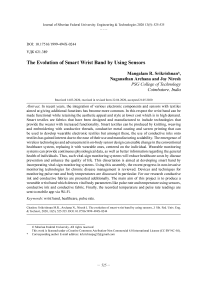The evolution of smart wrist band by using sensors
Автор: Srikrishnan Mangalam R., Archana Naganathan, Niresh Joy
Журнал: Журнал Сибирского федерального университета. Серия: Техника и технологии @technologies-sfu
Статья в выпуске: 5 т.13, 2020 года.
Бесплатный доступ
In recent years, the integration of various electronic components and sensors with textiles aimed at giving additional functions has become more common. In this respect the wrist band can be made functional while retaining the aesthetic appeal and style at lower cost which is in high demand. Smart textiles are fabrics that have been designed and manufactured to include technologies that provide the wearer with increased functionality. Smart textiles can be produced by knitting, weaving and embroidering with conductive threads, conductive metal coating and screen printing that can be used to develop wearable electronic textiles but amongst these, the use of conductive inks onto textiles has gained interest due to the ease of their use and manufacturing scalability. The emergence of wireless technologies and advancement in on-body sensor design can enable change in the conventional healthcare system, replacing it with wearable ones, centered on the individual. Wearable monitoring systems can provide continuous physiological data, as well as better information regarding the general health of individuals. Thus, such vital-sign monitoring systems will reduce healthcare costs by disease prevention and enhance the quality of life. This dissertation is aimed at developing smart band by incorporating vital-sign monitoring systems. Using this assembly, the recent progress in non-invasive monitoring technologies for chronic disease management is reviewed. Devices and techniques for monitoring pulse rate and body temperatures are discussed in particular. For our research conductive ink and conductive fabrics are presented additionally. The main aim of this project is to produce a wearable wrist band which detects vital body parameters like pulse rate and temperature using sensors, conductive ink and conductive fabric. Finally, the recorded temperature and pulse rate readings are sent to mobile app via Wi-Fi.
Wrist band, healthcare, pulse rate
Короткий адрес: https://sciup.org/146281639
IDR: 146281639 | DOI: 10.17516/1999-494X-0244
Список литературы The evolution of smart wrist band by using sensors
- Pailes-Friedman R. Smart Textiles for Designers: Inventing the Future of Fabrics. 2nd Edition, 2016.
- Muhammed Dawood, Richard Kennon. Preliminary Investigations into the development of textile based Temperature sensor for Healthcare Applications "Fibrers", 2013. - Access: www.mdpi.com/journal/fibers (ISSN 2079 - 6439).
- Sarah E. Braddock Clarke and Jane Harris. Digital Visions for Fashion and Textiles: Made in Code. 1st Edition, 2012.
- Sally Edwards. Heart Rate Monitor Book, 1993.
- Locher I., Kirstein T. & Tr¨oster G. Temperature Profile Estimationwith Smart Textiles, 2005.
- Maciej Sibinski, Malgorzata Jakubowska and Marcin Sloma. Sensors. Flexible Temperature Sensors on Fibers, 2010, 10, 7934-7946.
- Roy Benson and Declan Connolly. Heart Rate Training, 2011.
- Laukhina E., Laukhin V., Lebedev V., Rovira C. and Veciana J. Conductive fabric responding to extremely small temperature changes. Procedia Engineering, 87 (2014), 144-147. - Access: www.sciencedirect.com
- Vigneswaran C., Kandhavadivu P. Development of Electromagnetic Shielding Wearable Electronic Textile using Core Conductive Fabrics. International Journal of Science and Engineering Applications, 2013. NCRTAM ISSN - 2319 - 7560.
- Narendra V. Bhat, Devender T. Seshadri, Mandar M. Nate, Ajit V. Gore. Development of Conductive Cotton Fabrics for Heating Devices. Journal of Applied Polymer Science, 2006, 102 (5), 4690-4695.
- Masoud Latifi, Pedram Payvandy Rehman. Electro-conductive textile yarns, 2010.
- Abdul Rehman Akbar, Md. Kamruzzaman, Weilin Xu, Sayyam Gull, Waqas Ahmed, Junaid Khalid. Development of Weft Knitted Heating Pads on V-bed Hand Flat Knitting Machine by Using Conductive Yarns. American Journal of Polymer Science & Engineering, 2016, 4 (1).
- Muthukumar N., Thilagavathi G. Conductive Polymer Coated Textiles for Biosignal Monitoring. International Journal of Textile and Fashion Technology, 2012, 2 (2).
- Vlad Dragos Diaconescu, Liliana Vornicu-Albu, Rodica Diaconescu, Isabela Racea, Aurelia Grigoriu. Sensors for Smart Textiles. Buletinul AGIR nr. 3/2015.
- Šahta I., Baltina N., Truskovska J., Blums J. & Deksnis E. Selection of conductive yarns for knitting an electrical heating element. HPSM/OPTI, 2014, 137, 91-102.
- Ashok Kumar L., Vigneswaran C. Electronics in Textiles and Clothing: Design, Products and Applications, 2015.
- Novela Auparay. Room Temperature Seebeck Coefficient Measurement of Metals and Semiconductors, 2013.
- Liu Hao, Zhang Yi, Chen Li, Xiaojiu Li, Wang Yuxiu, Gao Yan. Characterization of Flexible Heating Fabric Based on Conductive Filaments. Measurement, 2012, 45 (7), 1855-1865.
- Julian T Parer. Handbook of fetal heart rate monitoring, 1983.
- Stoppa M., Chiolerio A. Wearable Electronics and Smart Textiles: A Critical Review, 2014, 14(7): 11957-11992.
- Chin Leong Lim, Chris Byrne, Jason K W Lee. Human Thermoregulation and Measurement of Body Temperature in Exercise and Clinical Settings. Annals of the Academy of Medicine, Singapore, 2008, 37(4): 347-353.


